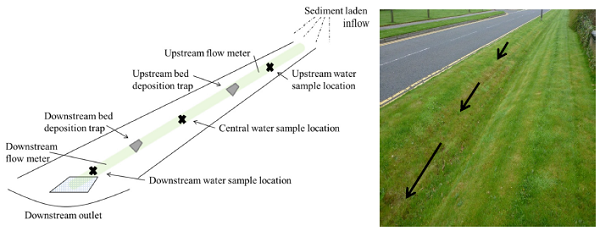
April 13, 2015, by Blue-Green team
Urban Sediment Transport through an Established Vegetated Swale: Long Term Treatment Efficiencies and Deposition
Deonie Allen (Heriot-Watt University) and colleagues have recently published a new paper in Water on their research as part of Blue-Green Cities WP2b (Sediment, Debris and Habitats). They investigated sediment transport through a vegetated swale, which can be classified as a sustainable urban drainage system (SuDS) and are present in many urban built environments. The team were particularly interested in determining the effectiveness of the swale in detaining sediment during rainfall-runoff events (an indication of the SuDS efficiency), to address a gap in the current literature surrounding mass and volume of sediment build up within swales over time and over a range of rainfall events.
Field research was undertaken within the Heriot-Watt University grounds, Edinburgh, Scotland, to identify the quantity of sediment from a single release that remains within the vegetated swale over an extended time period. A sediment transport dataset was created to illustrate the quantities of sediment the remains stationary or is re-suspended and transported downstream.
Sediment tracer methodology (Rare Earth Oxides (REOs)) was used to track the movement of the sediment. REOs absorb easily to natural sediment, have low rates of leaching once attached, and have been used in agricultural scour and erosion research. They are found naturally in very low quantities within soil and river bed material. REOs were attached to sediment particles and then released into the swale at the start of the monitoring period. A rainfall event was simulated to transport the sediment into the swale. The swale was monitored for a twelve month period, which included several natural rainfall events (and several artificial) that would influence the sediment transport dynamics.
- The study found that sediment continues moving through the vegetated swale after the initial rainfall-runoff event. This suggests that sediment is re-suspending and being conveyed during successive rainfall-runoff events. The rate of sediment loss is directly related to the intensity and duration of the rainfall event.
- The majority of sediment deposited within a swale is not, however, detained over the long-term or through the design life of the swale (typically 25-30 years). Instead, sediment is carried downstream by the water flow within the swale during rainfall events. This has important implications for the required maintenance regimes for these SuDS features.
This is the first study that employed REOs to effectively trace urban sediment transport through a vegetated swale. The full paper can be downloaded from the journal’s website (Water).
Allen, D., Olive, V., Arthur, S., Haynes, H., (2015). Urban Sediment Transport through an Established Vegetated Swale: Long Term Treatment Efficiencies and Deposition. Water, 7(3)1046-1067.
Read more about WP2b‘s progress via the Blue-Green Cities website.
No comments yet, fill out a comment to be the first

Leave a Reply